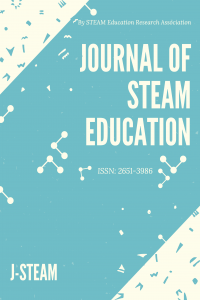Sustainable Environment and Climate Change in Children's Literature as A Popular Science Subject
Sustainable Environment and Climate Change in Children's Literature as A Popular Science Subject
Children's literature, climate change, environment popular science,
___
- Barratt Hacking, E., R. Barratt, and W. Scott. (2007). Engaging Children: Research Issues around Participation and Environmental Learning. Environmental Education Research 13(4), 529-544.
- Cabrera, A. (2011). Çevremize Özen Göstermek. (E. Geçgil, Çev.) Ankara: TÜBİTAK.
- Challoner, J. (2015). Enerji. (A. Ömer, Çev.) Ankara: TÜBİTAK.
- Chancellor, D. (2012). Hava. (A. B. Oğuz, Çev.) Ankara: TÜBİTAK.
- Clarke, C. (2013). Hava Durumu. (A. Alp, Çev.) Ankara: TÜBİTAK.
- Doğar, Ç., & Başıbüyük, A. (2005, Ekim). İlköğretim ve Ortaöğretim Öğrencilerinin Hava ve İklim Olaylarını Anlama Düzeyleri. Kastamonu Eğitim Dergisi, 13(2), 347-358.
- Eason, S. (2019). Ekoloji. (S. E. Emre, Çev.) Ankara: TÜBİTAK.
- Ganeri, A. (2013). Yağmur Ormanları. (U. Adem, Çev.) Ankara: TÜBİTAK.
- Guire Mc, B. (2013). Doğal Afetler. (M. S. Vapurlu, Çev.) Ankara: TÜBİTAK.
- Hedefalk, M., Almqvist, J., & Östman, L. (2015). Education for sustainable development in early childhood education: A review of the research literature. Environmental Education Research, 21(7), 975-990.
- Howell, L. (2019). Ağaçlar. (A. B. Arık, Çev.) Ankara: TÜBİTAK.
- Lynette, R. (2013a). Nehir Besin Zincirleri. (K. Bahtiyar, Çev.) Ankara: TÜBİTAK.
- Lynette, R. (2014). Dağ Besin Zincirleri. (K. Bahtiyar, Çev.) Ankara: TÜBİTAK.
- Mason, A. (2013). Doğa Karşısında İnsan. (B. Emine, Çev.) Ankara: TÜBİTAK.
- McLeish, E. (2013). Enerji Krizi. (B. Emine, Çev.) Ankara: TÜBİTAK.
- Meredith, S. (2012). Neden Dünyayı Önemsemeliyim? (A. Yalçın, Çev.) Ankara: TÜBİTAK.
- Moore, H. (20014b). Okyanus Besin Zincirleri. (K. Bahtiyar, Çev.) Ankara: TÜBİTAK.
- Moore, H. (2013a). Yağmur Ormanları Besin Zincirleri. (K. Bahtiyar, Çev.) Ankara: TÜBİTAK.
- Nam, H. (2017). Kalundborg Beşlisi. (G. Büşra, Çev.) Ankara: TÜBİTAK.
- Nikolaeva, S. N. (2008) The Ecological Education of Preschool Children. Russian Education & Society, 50(3), 64-72.
- Palattı, J. (2012). Doğal Felaketlerle Baş Etsek? (Ş. Korkusuz, Çev.) Ankara: TÜBİTAK.
- Pipe, J. (2013a). Rüzgar Enerjisi Güvenilir mi? (B. Emine, Çev.) Ankara: TÜBİTAK.
- Pipe, J. (2013b). Biyoyakıtlar. (T. Şafak, Çev.) Ankara: TÜBİTAK.
- Pipe, J. (2013c). Doğal Gaz. Ankara: TÜBİTAK.
- Roca, N. (2010). Atma Kullan. (O. Yener, Çev.) Ankara: TÜBİTAK.
- Silverman, B. (2014). Çayır Besin Zincirleri. (K. Bahtiyar, Çev.) Ankara: TÜBİTAK.
- UNESCO, (2005). United Nations Decade of Education for Sustainable Development (2005-2014): International Implementation Scheme. Paris: UNESCO.
- ISSN: 2651-3986
- Başlangıç: 2017
- Yayıncı: Şahin İDİN
The Effect of Science Festival on Participants' Attitudes Towards Science
Ebru YILMAZ İNCE, Ahmet KABUL, İbrahim DİLER
Sustainable Environment and Climate Change in Children's Literature as A Popular Science Subject
The Effects of Demographic Factors on High School Science Educators’ Technology Use
Zahrah ALJUZAYRİ, Brandy PLEASANT
Yatkınlıklar çevre yanlısı bir tutumu tanımlar
Mario SCHMİEDEBACH, Vivienne LİTZKE, Simon LAUMEN, Claas WEGNER
LGS SORULARININ PISA FEN OKURYAZARLIĞI BOYUTLARI AÇISINDAN İNCELENMESİ
